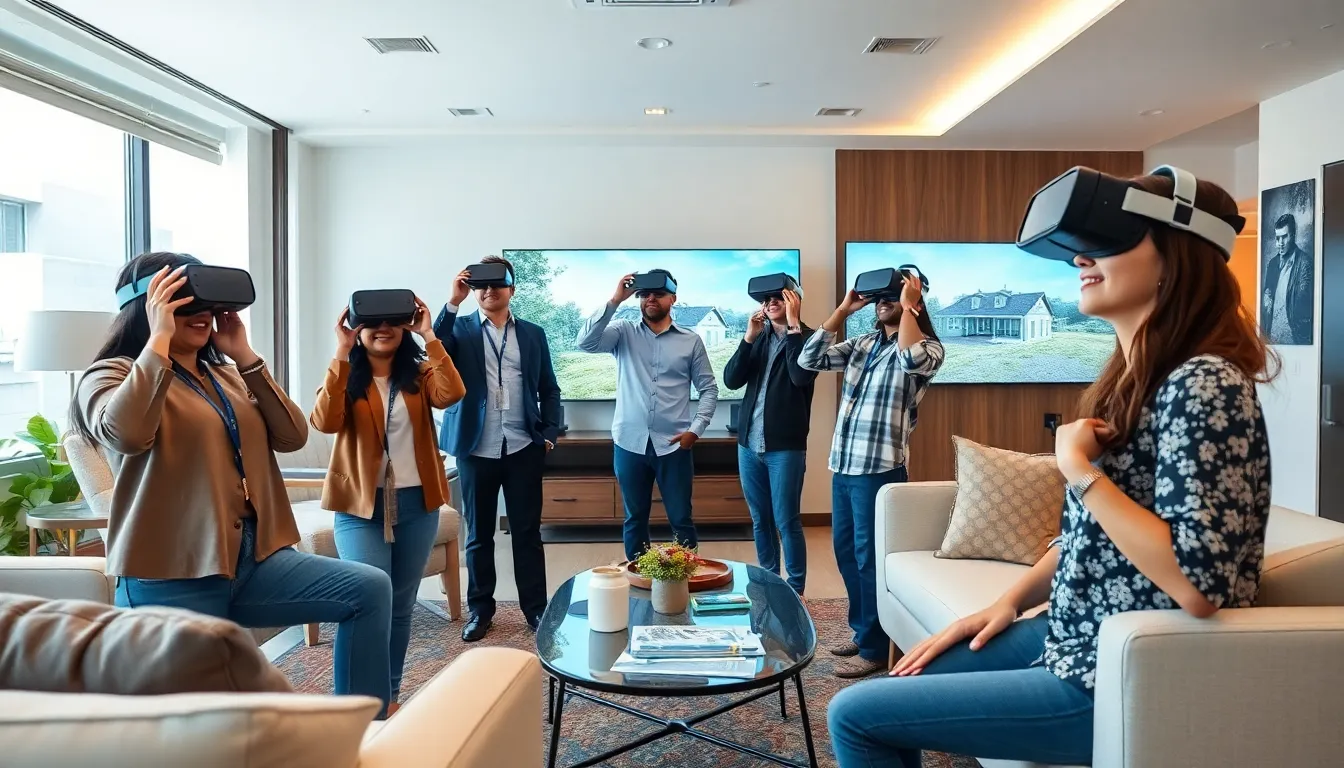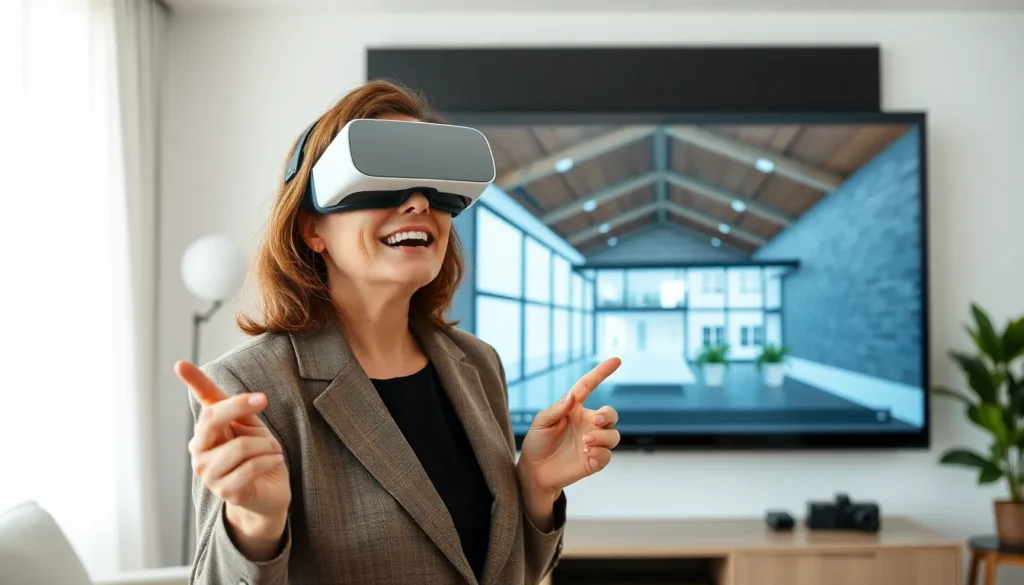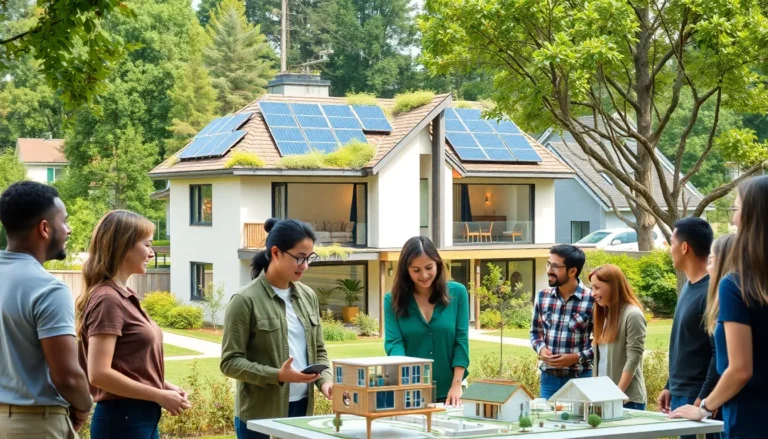Table of Contents
ToggleImagine touring your dream home without ever leaving your couch—sounds like magic, right? Welcome to the world of virtual reality real estate, where home buyers can explore properties in stunning detail without the hassle of traffic or awkward small talk with agents. With VR technology, potential buyers can walk through homes, peek into closets, and even visualize renovations all from the comfort of their living room.
This innovative approach is transforming the real estate market, making it easier and more fun for buyers to find their perfect match. Forget the days of scrolling through endless listings or attending open houses that feel more like a scavenger hunt. Virtual reality is here to make house hunting an exciting adventure, and it’s not just for tech geeks. Whether you’re a first-time buyer or a seasoned investor, VR real estate is changing the game and making property exploration a breeze.
Overview of Virtual Reality Real Estate
Virtual reality real estate represents a significant shift in how buyers interact with properties. This technology equips potential buyers with immersive experiences, enabling them to tour homes virtually. VR offers detailed views of rooms, allowing users to appreciate layout and design without physically being there. Users can explore different angles and perspectives, giving them a comprehensive understanding of the space.
Real estate agents leverage VR to showcase properties effectively. Many listings now include virtual tours, enhancing the marketing strategy. This method shortens the time spent on traditional showings and provides convenience to busy clients. Through VR, agents can reach a broader audience, making it possible for international buyers to explore homes from afar.
Customization options enhance the VR experience further. Potential buyers can visualize renovations or interior design changes instantly. Options for different color palettes and furnishings allow users to tailor spaces to their preferences. This interactive capability makes the buying process more engaging.
In addition, VR reduces costs associated with travel for property tours. It cuts down on logistics, enabling buyers to narrow down their selections before visiting physically. As the market evolves, this technology positions itself as a standard practice in real estate transactions. Virtual reality real estate stands as a promising trend, enhancing the overall efficiency of property buying.
Benefits of Virtual Reality in Real Estate

Virtual reality offers numerous advantages in the real estate sector, significantly enhancing the property buying process.
Enhanced Property Visualization
Virtual reality allows buyers to view properties in immersive detail. Buyers can explore different layouts, room sizes, and architectural features without physical limitations. They can visualize customization options, such as paint colors or furniture arrangements. Additionally, VR technology enables realistic walkthroughs, helping individuals understand spatial relationships more effectively. This detailed perspective leads to informed decision-making, reducing the chances of buyer’s remorse. With VR, potential buyers gain a clear understanding of what a property offers before making commitments, ensuring a smoother transaction process.
Improved Buyer Engagement
Engagement levels rise when buyers interact with properties through VR. This technology provides an interactive experience that captivates potential buyers’ interest. Buyers can navigate spaces at their own pace, enhancing their connection with the property. Engaging visual elements, such as virtual furniture and landscape options, contribute to a dynamic exploration experience. Using VR enhances focus, leading to more productive discussions with real estate agents. Furthermore, virtual tours appeal to both local and international buyers, expanding market reach. This increased engagement helps create stronger emotional connections, making properties more memorable and desired.
Technology Behind Virtual Reality Real Estate
Virtual reality in real estate relies on robust technological foundations, integrating specialized hardware and software to create immersive experiences.
Hardware Requirements
Virtual reality headsets play a crucial role in delivering an engaging experience. Popular options include Oculus Rift, HTC Vive, and PlayStation VR, each providing distinct features. Graphics processing units (GPUs) enhance visual fidelity, enabling realistic property representations. Additionally, powerful computers or gaming consoles are necessary to support the processing demands of VR environments. Motion controllers facilitate user interaction, allowing buyers to explore spaces more intuitively. High-quality audio equipment enriches the experience by adding soundscapes that reflect real environments. Collectively, these hardware components ensure a seamless and captivating virtual exploration of properties.
Software Solutions
Many software platforms specialize in virtual reality real estate applications. 3D modeling software, such as SketchUp or Revit, creates detailed digital representations of properties. VR-specific applications, like Matterport or Immoviewer, offer virtual tour functionalities, enabling users to navigate through properties remotely. Customization tools allow buyers to visualize potential renovations or interior designs. Additionally, integration with real estate listing services ensures that potential buyers have access to up-to-date property information. These software solutions enhance the overall experience by providing interactive and informative environments tailored to user needs.
Challenges Faced by Virtual Reality Real Estate
Virtual reality in real estate introduces unique challenges that can impact its effectiveness and adoption.
Cost Considerations
High upfront costs create a significant barrier. Investment in VR technology often includes purchasing advanced hardware such as headsets and computers with powerful GPUs. Additionally, developing high-quality virtual tours can incur considerable software expenses. Pricing for VR platforms varies, with some programs requiring monthly subscriptions. Maintenance costs further contribute to financial hurdles. Real estate agents and agencies must weigh potential returns against these investments, complicating decision-making in integrating VR solutions.
User Adoption Issues
Adoption rates present another challenge, as many potential users lack familiarity with VR technology. Some individuals may feel overwhelmed by the prospect of using headsets and navigating virtual spaces. Lack of exposure can lead to reluctance in using these immersive experiences. Moreover, generational gaps exist, with older buyers preferring traditional methods. Addressing these concerns requires strategic marketing that emphasizes user-friendly experiences. Providing help resources and guided tours fosters confidence, encouraging more users to embrace VR as a viable tool in their property searches.
Future Trends in Virtual Reality Real Estate
Artificial intelligence integration with virtual reality will enhance personalization in real estate experiences. Automated algorithms will analyze buyer preferences, tailoring virtual tours to show relevant properties. Enhanced machine learning applications could streamline property searches significantly.
Augmented reality features may also emerge within VR platforms. Potential buyers might overlay digital information on physical spaces, offering real-time insights during property tours. This technology could provide live metrics about a property’s energy efficiency or renovation potential.
Mobile VR experiences are expected to gain traction. Users will likely access virtual tours directly from smartphones or tablets. Such accessibility will attract a younger demographic already familiar with mobile technology.
Commercial real estate could witness transformative changes through VR as well. Businesses may use virtual environments to showcase office spaces, helping prospective tenants visualize layouts and amenities. Enhanced virtual meetings could facilitate negotiations and discussions, further accelerating decision-making processes.
Increasing collaboration among real estate professionals could shape best practices in VR. Agents may form partnerships to share resources and VR content, expanding their reach and improving service offerings. Networking events centered around VR technology may also promote knowledge sharing.
Regulatory advancements might further influence the acceptance of VR in real estate. Local governments could start placing regulations on virtual property listings, ensuring transparency and authenticity. Such regulations might help protect both buyers and sellers in this evolving landscape.
These trends are set to redefine how individuals interact with real estate. With advancements in technology, engaging virtual experiences will become standard, enhancing the overall buying journey. Ultimately, virtual reality aims to create a more efficient and enjoyable process for all stakeholders involved.
Virtual reality is revolutionizing the real estate landscape by offering immersive experiences that enhance property exploration. As buyers increasingly seek convenience and engagement in their home searches, VR technology stands out as a game changer. It not only streamlines the buying process but also fosters deeper emotional connections with properties.
Despite some challenges related to cost and user adoption, the potential for VR in real estate remains immense. Future innovations such as artificial intelligence integration and mobile VR experiences are set to further enhance accessibility and personalization. As the industry embraces these advancements, virtual reality will likely become a standard tool, making the journey to finding a dream home more efficient and enjoyable for everyone involved.




